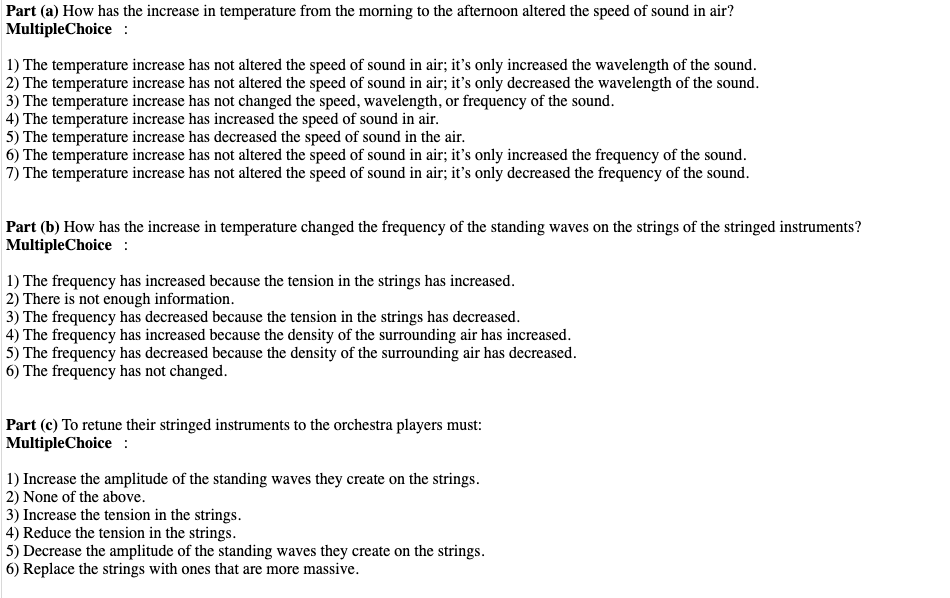Part (a) How has the increase in temperature from the morning to the afternoon altered the speed of sound in air? MultipleChoice : | 1) The temperature increase has not altered the speed of sound in air; it's only increased the wavelength of the sound. 2) The temperature increase has not altered the speed of sound in air; it's only decreased the wavelength of the sound. 3) The temperature increase has not changed the speed, wavelength, or frequency of the sound. 4) The temperature increase has increased the speed of sound in air. 5) The temperature increase has decreased the speed of sound in the air. 6) The temperature increase has not altered the speed of sound in air; it's only increased the frequency of the sound. 7) The temperature increase has not altered the speed of sound in air; it's only decreased the frequency of the sound. Part (b) How has the increase in temperature changed the frequency of the standing waves on the strings of the stringed instruments? MultipleChoice : 1) The frequency has increased because the tension in the strings has increased. 2) There is not enough information. 3) The frequency has decreased because the tension in the strings has decreased. 4) The frequency has increased because the density of the surrounding air has increased. 5) The frequency has decreased because the density of the surrounding air has decreased. 6) The frequency has not changed. Part (c) To retune their stringed instruments to the orchestra players must: MultipleChoice : | 1) Increase the amplitude of the standing waves they create on the strings. 2) None of the above. 3) Increase the tension in the strings. 4) Reduce the tension in the strings. 5) Decrease the amplitude of the standing waves they create on the strings. 6) Replace the strings with ones that are more massive
Properties of sound
A sound wave is a mechanical wave (or mechanical vibration) that transit through media such as gas (air), liquid (water), and solid (wood).
Quality Of Sound
A sound or a sound wave is defined as the energy produced due to the vibrations of particles in a medium. When any medium produces a disturbance or vibrations, it causes a movement in the air particles which produces sound waves. Molecules in the air vibrate about a certain average position and create compressions and rarefactions. This is called pitch which is defined as the frequency of sound. The frequency is defined as the number of oscillations in pressure per second.
Categories of Sound Wave
People perceive sound in different ways, like a medico student takes sound as vibration produced by objects reaching the human eardrum. A physicist perceives sound as vibration produced by an object, which produces disturbances in nearby air molecules that travel further. Both of them describe it as vibration generated by an object, the difference is one talks about how it is received and other deals with how it travels and propagates across various mediums.
An orchestra contains both string and wind instruments. The orchestra tunes their instruments in the morning at a temperature at Tc=15 degrees celsius. As they play, the temperature rises in the afternoon to Th= 30 degrees celsius and falls in the later evening back to Tc= 15 degrees celsius. As usual, the speed of sound in air increases with increasing temperature.

Trending now
This is a popular solution!
Step by step
Solved in 3 steps

what happens if the temp drops back to Tc? What do you need to do to the instruments then?








